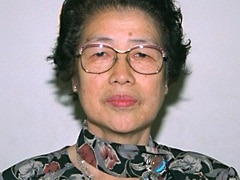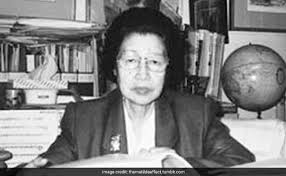Katsuko Saruhashi Biography – Japanese geochemist: Bio | Age | Awards | Books | Death | Books |Family | Facts


Katsuko Saruhashi was a geochemist, born 22 March 1920 – 29 September 2007, who initially carried out carbon dioxide (CO2) tests in seawater and then showed the danger of radiation loss in seawaters and the atmosphere.
Her other important area was to increase the number and status of women scientists in Japan in particular. The Society of Japanese Women Scientists is founded and the Katsuko Saruhashi Award is awarded annually for the young women scientists as a model.
Katsuko Saruhashi was the First Woman to receive a Ph.D. in Chemistry at the prestigious University of Tokyo and the Miyake Prize for Geochemistry, among other honors. She was elected to the Science Council of Japan.
Also read: How To Make Selfies with Dorian Rossini
Katsuko Saruhashi was killed by pneumonia in Tokyo on 29 September 2007. She’s eighty-seven. Her contributions to the geochemical science are recalled not only for her encouragement but also for her faith in the advancement of women in science and for the search for global peace.
Professional and Education life

Born in Tokyo, in 1943 Katsuko Saruhashi graduated from the Imperial Women’s University (precursor to Toho University). Later she entered and worked in the Geochemical Laboratory of the Institute of Meteorological Research which was part of the Central Meteorological Observatory. She began to study the level of CO2 in seawater in 1950. CO2 rates were not known at that time as significant, and Katsuko Saruhashi had to establish its own calculation methods.
Katsuko Saruhashi graduated from Tokyo University with a D.A. in Chemistry in 1957 and was the first student to do so.
Work with Teruko Kanzawa was performed between 1973 and 1978 by Katsuko Saruhashi. They started work in the “Institute of Meteorological Work of the meteorological Administration” in Tokyo with a pH of all rainfalls over a five-year period. On average, the tests reported that the pH is roughly 4,52, a development of 4,1 over the past years of Miyake’s 1939 investigations. Miyake says the pH varied in various seasons (summer and winter), but that there is no difference between seasons in Saruhashi’s results, which shows how conditions have changed in the 1970s.
Results of the Bikini Atoll nuclear test
The Japanese Government ordered the Geochemical Laboratory to examine and track radioactivity of ocean water and precipitation after the nuclear tests at Bikini in 1954. At the time of the trials, a Japanese fishing trawler was wind-down and its crew was sick. Katsuko Saruhashi discovered that the radioactivity in the seawater in Japan took one and a half years.
In 1964, the levels of radiation revealed that ocean water from the west and east of the Northern Pacific had combined completely and that radioactivity signs had accumulated all over the Pacific in 1969. This was one of the first studies showing that radiation impacts would spread throughout the world rather than just impact the immediate area. Katsuko Saruhashi turned her mind later, in the 1970s and 1980s, to the research and consequences of acid rain.
Must visit: Sake Dean Mahomed: Biography, Life, Family | First Indian author who published a book in English
Artificial seawater radioisotopes
The Japanese Government demanded that Katsuko Saruhashi together with Yasuo Miyake–lead a research project on the long-term and regional implications of these experiments, in response to the inflow of nuclear tests in the Pacific. For that reason, Katsuko Saruhashi was working on a new system for calculating radiation influence at the Central Meteorological Observatory in Tokyo. In their document’ Cesium 137 and Strontium 90 in Sea Water,’ Katsuko Saruhashi and Miyake’s research findings were explained.
Their studies concluded that in the Western North Pacific, there were substantially higher amounts of Sc-137 and Sr-90 than were found in samples obtained from the Atlantic and Northeast Pacific. Given these results, Saruhashi and Miyake concluded that the differing quantities of artificial radioisotopes found in the Pacific were a direct consequence of the nuclear testing occurring in the Pacific Tropics.
Although the evidence of Saruhashi’s argument of numerical differences of Cesium-137 and Strontium-90 in different parts of the Atlantic and North Pacific was corroborated, the statement was challenged by American Scientists, who doubted the process and methodology used by the Saruhashi group.
Seawater CO2 absorption

In 1956, Katsuko Saruhashi and Miyake explored very closely how organic oxidation helped to improve the levels of carbon dioxide in seawater. Beyond their study, it was believed that the dissolution of calcium carbonate resulted from the high carbon dioxide and alkalinity values present in the oceans. Katsuko Saruhashi concluded that this theory is unfounded, and researchers could no longer believe that the supposed capacity of seawater to trap carbon dioxide gas could actually alleviate global warming.
Instead, Katsuko Saruhashi and Miyake provided empirical proof that seawater emits twice the amount of CO2 that it absorbs in the Pacific.
Also read:
World War II experience
- Saruhashi, Kuniharu and Kuno Saruhashi, were born in 1920 in Tokyo.
- Sitting down a window, a little Saruhashi was sitting in primary school watching raindrops fall.
- Katsuko Saruhashi had an intellectual interest, which his mother always sponsored after a common Second World War experience. He was adamant that women needed technical know-how to achieve independence.
- Katsuko Saruhashi studied at Toho University and graduated in 1943 from that Imperial Women’s College of Science.
First doctorate
- Saruhashi encountered someone during her studies who would become her eventual mentor. The meteorological research institute, Miyake Yasuo offered her a position.
- Katsuko Saruhashi had an opportunity to study carbon dioxide in seawater during her time.
- Katsuko Saruhashi said when she began, she had to develop her own gas measuring techniques. “Anyone is concerned about carbon dioxide now, but nobody was at that time,” she said.
- Katsuko Saruhashi explained that around half the emission of carbon dioxide into the atmosphere from the Pacific Oceans was consumed so that climate change could not be defended against.
- Katsuko Saruhashi was the first woman to receive a Ph.D. in Chemistry from Tokyo University in 1957 for her research.
Nuclear bombs
- Saruhashi and her colleagues also were identified as part of the world’s first explosives unit to investigate the impact of explosions in the world studied by the US and the Soviet Union.
- Katsuko Saruhashi found radioactivity on the coast of Japan. She was one of the first to investigate nuclear testing issues; her evidence was later used to prevent nuclear testing by these governments.
- Saruhashi is hardly discussed in Western discussions on climate change or the risks of radiation monitoring in light of her pioneering work.
- Katsuko Saruhashi died at the age of 87 on 29 September 2007.
Recognition
- Saruhashi was the first woman to receive a Ph.D. in Chemistry from Tokyo University in 1957.
- Katsuko Saruhashi was the first female to be elected to the National Parliament of Research, Science Council of Japan in 1980.
- Katsuko Saruhashi was the first woman to receive the Miyake Geochemistry Award in 1985 and set up her own Suruhashi prize, which honored women scientists who served as mentors and role models for younger women scientists.
- “I wanted to highlight female scientists ‘ skills, which were historically hidden, under the water,” Katsuko Saruhashi said.
- In 1993, the Society for Sea Water Sciences awarded her the Tanaka Award.
10 things Katsuko Saruhashi needs to know
- In 1943, she graduated from the Imperial College of Female Science and joined the Institute of Meteorological Research and her Geochemical Laboratory was established.
- The first carbon dioxide (CO2) levels in seawater experiments were carried out by Katsuko Saruhashi.
- Katsuko Saruhashi first earned a Ph.D. in chemical engineering from Tokyo University in 1957.
- “I want to see the day when women can make an equal contribution towards science and technology,” she said. “There are many women that are capable of becoming great scientists,” Katsuko Saruhashi said.
- Katsuko Saruhashi made a number of groundbreaking geochemical discoveries. It developed its own calculation table called Saruhashi’s Table, based on the temperature level, pH level and chlorinity, to determine the amount of carbonic acid in water.
- Katsuko Saruhashi was the first woman to win Japan’s Miyake Prize in Geochemistry, and the first to have been nominated to the Scientific Council of Japan.
- Katsuko Saruhashi is also remembered for her work to ensure that other women got a chance to make scientific breakthroughs like she did. Saruhashi inspired several women to pursue science.
- Katsuko Saruhashi established the Saruhashi Prize for excellent Japanese women researchers, which has been awarded since 1981 annually.
- In the 1970s and 1980s, Katsuko Saruhashi was attracted to science because of her obsession and interest with raindrops.
- Katsuko Saruhashi died on September 29, 2007, after fighting pneumonia at her home in Tokyo. Katsuko Saruhashi was 87 years old.
People Also Search For Katsuko Saruhashi
- When is the birthday of Katsuko Saruhashi?
- When Katsuko Saruhashi dies, how old was she?
- Katsuko Saruhashi family?
- Katsuko Saruhashi is known for that?
- The honors won by Katsuko Saruhashi?
- Katsuko Saruhashi images?
- Katsuko Saruhashi nationality?
- Would Katsuko Saruhashi do any drugs? Would Katsuko Saruhashi Smoke Cigarettes or Weed?
- What is Net Worth of Katsuko Saruhashi? How much is Katsuko Saruhashi worth it?
- where did Katsuko Saruhashi live
Read Also:
- Free Movies & TV Serials Download Sites For 2019
- Source Code for final year college student
- 9xMovie 2019 | 9xmovies Download Latest Bollywood, Hollywood, Tamil, South Indian Movies
- The PirateBay Proxy List For 2019 [100% Working Mirror Sites]
- Top 15 Kickass Torrent Mirror Sites and Pirate Proxy 2019 [100% Working Kickass Torrents]
- MovieRulz 2019-Watch & Download Latest Movies Telugu, Bollywood & Hollywood Movies
- Filmywap 2019: website for Bollywood, Hollywood, Hindi, Punjabi Movies
- HR E-Mail Id’s
- 30+ NEW RARBG Proxy List of RARBG Offical Mirror sites and Proxies
- CouchTuner Best Alternatives for Watch Web Series Free Online
- ExtraTorrent Proxy & ExtraTorrent Alternatives Sites [100% Working]
- Top 12 Putlocker Alternatives 2019 to Stream Movies Online
- Top 12 Best Alternatives to GoGoAnime to Watch Free Anime Series Online
- Best FMovies Alternative sites to Download Movies and TV Shows
- 10 Best YIFY Torrents Fastest Proxies and Mirrors – Xtorrent
- Best Torlock Alternative Websites and Unblock Mirror Sites and VPN
- GoMovies Website Alternatives to Watch Movies Online Free
- LetMeWatchThis (PrimeWire) Similar Sites And Alternatives
- Best Primewire Alternatives Sites for Movie Streaming
- Tamilyogi – Download Hindi, Telugu, Tamil HD Movies Online Free




